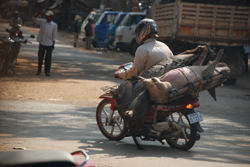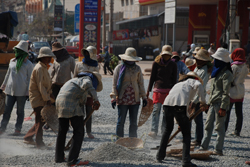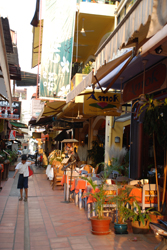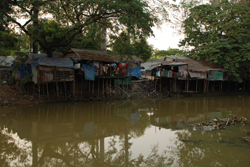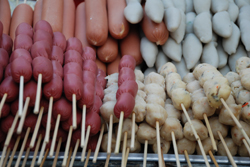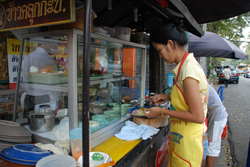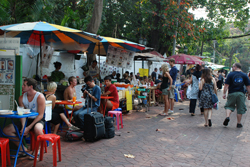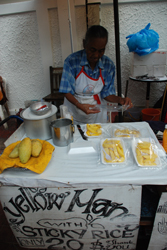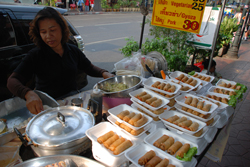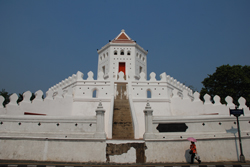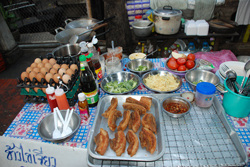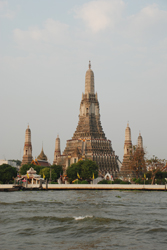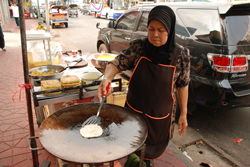Luxury Life in one of the Poorest Countries in Asia
29 January, 2009, 02:39 am in "Cambodia"
The slick new road into town was bordered with palatial luxury hotels with names containing words like “Royal” or “Empress”. Only a little while before, the only buildings we saw were simple wood huts on stilts with no glass windows or screens, just wooden shutters. These rose from marshy areas. During the rainy season they would rest on the surface of the lakes, ponds and rivers they bordered. I'm not sure what happens to the road.
The landscape was flat and stretched off into the distance, making the sky seem larger. Rice plants grew in paddies, poking out of a thin layer of water. White cattle grazed, drifting across the paddies like clouds.
People in wide hats and krama scarves to shield themselves from the sun, stood in muddy pools fishing using nets. This fit more with how I imagined Cambodia would be and, in truth, it is. Arriving in Siem Reap is like being suddenly transplanted onto another planet. The streets we walked down are full of stylish hotels, gourmet restaurants, spas, galleries, and chic boutiques. However, this is luxury everyone can afford... well... except the average Cambodian.
People in wide hats and krama scarves to shield themselves from the sun, stood in muddy pools fishing using nets. This fit more with how I imagined Cambodia would be and, in truth, it is. Arriving in Siem Reap is like being suddenly transplanted onto another planet. The streets we walked down are full of stylish hotels, gourmet restaurants, spas, galleries, and chic boutiques. However, this is luxury everyone can afford... well... except the average Cambodian.
Someone at some point presented a theory that you can tell what is the most important/powerful feature of a society by looking at the largest buildings. For example: first the largest buildings were for religion- zigurats in Sumer because the priests were most important. Then the kings gained power so castles and palaces were the largest. Then business took priority and the cities gained skyscrapers. Well, in Siem Reap, by this standard, the tourist is king and hotels are dwarfing the wats that had earlier claimed this position of priority. Ironically, it is Angkor Wat that has made this a tourist town.
However, it is amazing how this luxury world slips away once you are out of the center. Suddenly the buildings shrink back down to one story shops with thin wooden walls and traditional wooden stilt houses occupying spots next to the river. The pavement gives way to sandy roads and the wats re-claim their position of dominance in society.
However, it is amazing how this luxury world slips away once you are out of the center. Suddenly the buildings shrink back down to one story shops with thin wooden walls and traditional wooden stilt houses occupying spots next to the river. The pavement gives way to sandy roads and the wats re-claim their position of dominance in society.
The hotels are still encroaching and across from the stilt houses, new multistory hotels are springing up. The contrast of the center and the area outside is startling. I'm really curious how tourism is helping and/or harming the society. It looks like it is bringing a lot of money and providing a lot of jobs and new businesses. But are many of the businesses owned by foreigners? It is a very sophisticated tourist scene with lots of emphasis on fine art, gourmet food and spas. How did it get to be this way? Is it getting out of control? There are also a lot of NGOs that seem centered here.
From Bangkok to Siem Reap: Buses, pickup trucks, and tuk tuks
28 January, 2009, 02:39 am in "Cambodia"
Our journey from Bangkok to Siem Reap started around 6:15 AM. The bus ride to the bus station went smoothly getting us to the station 10 minutes before the bus to the border left. This bus took about 4 ½ hours to get to the border town, Aranyaprathet. From here we caught a tuk tuk which, after being screamed at for trying to take us to a fake Cambodian Consulate, took us to the real border.
We walked to Cambodia (over a bridge) and went to get our Cambodian visa. The visa costs $20 but the guards want to over charge. Of course they said they couldn't break the $100 bill so we had to pay in baht. They said each visa would cost 1000 baht (about $30) for “express service”. We finally settled for about $25 (800 baht) which is the same price as an e-visa, a reasonable compromise, for “non-express” service. We had our visas in about 2 minutes which made us speculate how fast “express” service must be.
We walked a bit to get out of tout range, and found a pick-up truck going to Sisophan. There were just 2 people in the back and a lot of plastic containers. We boarded. I sat on a spare tire and Rowshan on the edge of the truck bed with the other 2 truck bed passengers. Then we saw/smelled that the containers had been used for fish. There was a big plastic bag of fish and a small bucket with a few fish lying in it.
Once the pickup was moving, the fish smell blew off. It was actually quite enjoyable riding in the pick-up bed. The rush of wind cooled us and the road was surprisingly good-- a new one. The landscape spread out in green, gold and browns. Before reaching Sisophon, the driver turned down a very bumpy dirt road. We stopped in front of a small wooden house and 4 women who had been riding inside the truck cab, climbed out and claimed their plastic tubs, nets, and leftover fish. I guess they are fisher families who had brought their catch to sell at one of the border markets.
In Sisophon, we quickly got into a shared taxi. The road will one day be new but at the moment consists of stretches of new pavement interspersed with stretches of graded dirt. It looks like they are planning to pave it soon. There have been several new bridges put in but are not operable yet so we detoured on dirt paths around them. It is dry season so there isn't much water under them. We arrived in Siem Reap around 4:30 PM or 5.
We walked to Cambodia (over a bridge) and went to get our Cambodian visa. The visa costs $20 but the guards want to over charge. Of course they said they couldn't break the $100 bill so we had to pay in baht. They said each visa would cost 1000 baht (about $30) for “express service”. We finally settled for about $25 (800 baht) which is the same price as an e-visa, a reasonable compromise, for “non-express” service. We had our visas in about 2 minutes which made us speculate how fast “express” service must be.
We walked a bit to get out of tout range, and found a pick-up truck going to Sisophan. There were just 2 people in the back and a lot of plastic containers. We boarded. I sat on a spare tire and Rowshan on the edge of the truck bed with the other 2 truck bed passengers. Then we saw/smelled that the containers had been used for fish. There was a big plastic bag of fish and a small bucket with a few fish lying in it.
Once the pickup was moving, the fish smell blew off. It was actually quite enjoyable riding in the pick-up bed. The rush of wind cooled us and the road was surprisingly good-- a new one. The landscape spread out in green, gold and browns. Before reaching Sisophon, the driver turned down a very bumpy dirt road. We stopped in front of a small wooden house and 4 women who had been riding inside the truck cab, climbed out and claimed their plastic tubs, nets, and leftover fish. I guess they are fisher families who had brought their catch to sell at one of the border markets.
In Sisophon, we quickly got into a shared taxi. The road will one day be new but at the moment consists of stretches of new pavement interspersed with stretches of graded dirt. It looks like they are planning to pave it soon. There have been several new bridges put in but are not operable yet so we detoured on dirt paths around them. It is dry season so there isn't much water under them. We arrived in Siem Reap around 4:30 PM or 5.
Street Food in Thailand
27 January, 2009, 03:58 am in "Thailand"
Easing into the Street with Soup.
Rice Noodle Soup (Kuaytyaw): This soup is everywhere. It consists of noodle soup with vegetables, egg, and mystery balls (probably pork but they have such a weird consistency I think mystery balls is a more appropriate description... it is sometimes best not to know.) We ate it on the street but in truth it was actually made in a restaurant. But it was a border-line restaurant: a store front open to the street where a food cart prepared food in the front. There were a few tables inside and a few outside. It was located on Th. Phra Sumen near the Fort.We made the mistake of adding hot pepper before tasting it because I'd seen someone with a bunch added to their soup. A tiny amount made the soup unbearably spicy. Oh Yah... Thais like very spicy food.
Some Cold Dishes for Hot Days
Rowshan had Kraw-pud-nam-prig-long-rua which was cold rice salad with vegis, omelette, and a kind of a meat paste sauce with peppers, and lemon grass. I had Ka-nom-jeen souw nam which was cold rice noodles with pineapple, coconut milk, lemongrass, lime, peppers, eggs, and I think carrot sauce.
It was very tasty costing 30 baht each. (less than $1). I think last time we were in Thailand most street food was 25 baht which was about 50 cents which shows how much the dollar has fallen. Located on Th. Phra Athit near fort.
It was very tasty costing 30 baht each. (less than $1). I think last time we were in Thailand most street food was 25 baht which was about 50 cents which shows how much the dollar has fallen. Located on Th. Phra Athit near fort.
Mango Sticky Rice Road (Soi Rambutri or thereabout)
Though we are staying in Bangalampu we have thus far managed to avoid Kao San. We went there last visit for bus tickets and we hated it. I can only think it has gotten worse.
We have however gone to a street that serves as a kind of extension of Kao San-- Soi Rambutri, because it has a wide array of street food vendors with convenient menus in English and regular street food prices (20-35 baht per serving) We stumbled upon the street accidentally and didn't like it. Rows of guesthouses with bar/restaurants, vendors selling T-shirts, clothing and other stuff and a mass of tourists.
Unfortunately, it is the cheapest place we've found so far for mango sticky rice (Khao niew mamuana) (20 baht). (We've only looked for it around here and Siam square (20 baht for rice, 50 for plate of mangos). Mango sticky rice doesn't seem too difficult. Put a hunk of sticky rice, slice mangos and pour coconut milk on it. We like buying from this little old woman who we think should be retired and not hanging out late selling sticky rice. On Mango Sticky Rice Road we had some nice fruit shakes (20-30 baht) and some good phad Thai as well as some really pathetic phad thai (more like steamed noodles than fried).
We have however gone to a street that serves as a kind of extension of Kao San-- Soi Rambutri, because it has a wide array of street food vendors with convenient menus in English and regular street food prices (20-35 baht per serving) We stumbled upon the street accidentally and didn't like it. Rows of guesthouses with bar/restaurants, vendors selling T-shirts, clothing and other stuff and a mass of tourists.
Unfortunately, it is the cheapest place we've found so far for mango sticky rice (Khao niew mamuana) (20 baht). (We've only looked for it around here and Siam square (20 baht for rice, 50 for plate of mangos). Mango sticky rice doesn't seem too difficult. Put a hunk of sticky rice, slice mangos and pour coconut milk on it. We like buying from this little old woman who we think should be retired and not hanging out late selling sticky rice. On Mango Sticky Rice Road we had some nice fruit shakes (20-30 baht) and some good phad Thai as well as some really pathetic phad thai (more like steamed noodles than fried).
Fried Sweets and Spring Rolls
In the morning, on Th. Chakra Phong, there are a lot of vendors making fried sweets. We bought some fried peanut cookies-- crunchy flat dough with lots of peanuts sticking out. They weren't too sweet but were very peanutty, though a little greasy. Later they seem to close shop so buy sweets earlier in the day.
We found numerous spring roll vendors close to the intersection of Chakraphong and Rambutri. I'm a big fan of fried spring rolls. We got 5 small ones and sweet and sour sauce for 25 baht. They contained just vegetables (no noodles) but were also available with chicken. There seems to be lots of fried food. However, they are also really good at deep frying in a way that doesn't produce overly greasy food.
We found numerous spring roll vendors close to the intersection of Chakraphong and Rambutri. I'm a big fan of fried spring rolls. We got 5 small ones and sweet and sour sauce for 25 baht. They contained just vegetables (no noodles) but were also available with chicken. There seems to be lots of fried food. However, they are also really good at deep frying in a way that doesn't produce overly greasy food.
Santichaiprakan Park vendors
Santichaiprakan Park and the Pra Saman Fort are very close to where we are staying. Conveniently, there are several food vendors who set up here. We've tried the fried rice (khao paad) and spicy basil rice (Khao phad krapow).
I love watching how vendors prepare the food. It is done quickly as if no thought is involved at all. For the spicy basil rice she put some oil in the wok, threw in some red pepper paste with pieces of pepper, then added chicken, the basil, bean pieces. Then she added some water, a dash from various bottles, and a bit of sugar. She then scooped out some rice, put the meat and vegis on top. We've also gone to the park for a cheap breakfast of rice and Thai omelet-- egg with green onion, a bit of soy and fish sauce for 15 baht.
I love watching how vendors prepare the food. It is done quickly as if no thought is involved at all. For the spicy basil rice she put some oil in the wok, threw in some red pepper paste with pieces of pepper, then added chicken, the basil, bean pieces. Then she added some water, a dash from various bottles, and a bit of sugar. She then scooped out some rice, put the meat and vegis on top. We've also gone to the park for a cheap breakfast of rice and Thai omelet-- egg with green onion, a bit of soy and fish sauce for 15 baht.
Red curry for Chinese New Year
Instead we went to the corner of the intersection and bought cold noodles with red curry sauce and mystery balls. The table had mint, dill and basil leaves along with bean sprouts, pickles, cabbage and beans to be added per ones desire.
Steamed spring rolls
We were up early hoping to catch the light on Wat Arun from the river. Walking along Th. Maharat we saw a vendor near the Tha Tien Pier making steamed spring rolls. She had the ingredients in front of her-- tofu pieces, black Chinese mushrooms, cabbage, dried shrimp, and thick rice noodle wrappers. The bundles were steamed, then she placed them in a box, cut them in pieces with scissors, sprinkled dried fish flakes and Chinese parsley and served with a bag of spicy teriyaki sauce.
Roti Mataba
A woman on Th. Phra Sumen near the Fort, has a flat skillet. She makes roti as well as mataba which is a thin roti bread packet with a mix of egg, carrots, onions, and peppers inside, fried on the skillet. She serves them cut in pieces with onions, cucumbers, and peppers on top. At first I watched in horror as she squirted what looked like a lot of oil all over. To our relief it turned out to be a sweet and sour sauce. I haven't encountered these before but when I asked she said they were Thai food. Roti= bread, mataba= filled. I believe it is a dish from Southern Thailand. Price: 30 baht.
Powered by My Blog 1.69. Copyright 2003-2006 FuzzyMonkey.net.
Created by the scripting wizards at FuzzyMonkey.net..
(Code modified by Rowshan Dowlatabadi)
Created by the scripting wizards at FuzzyMonkey.net..
(Code modified by Rowshan Dowlatabadi)


